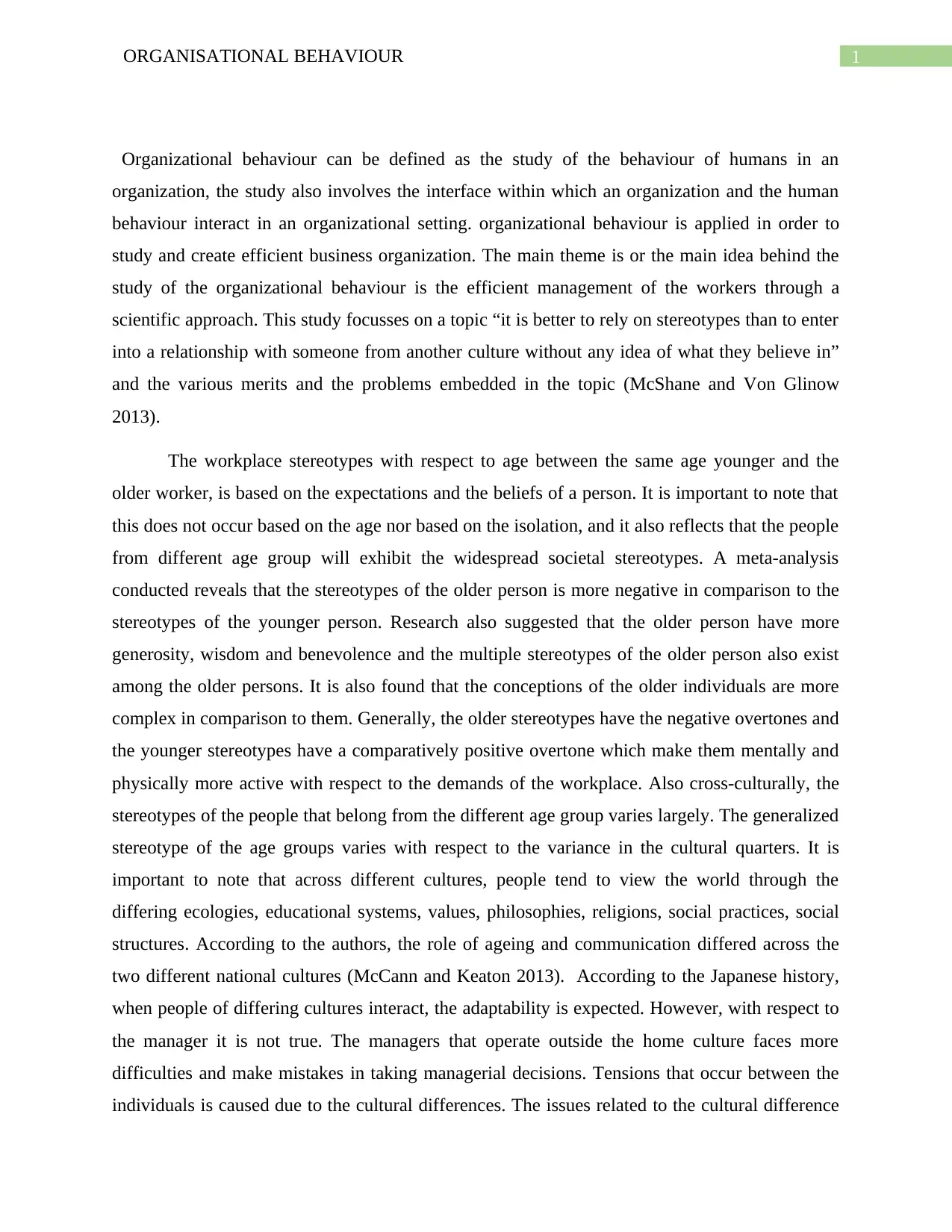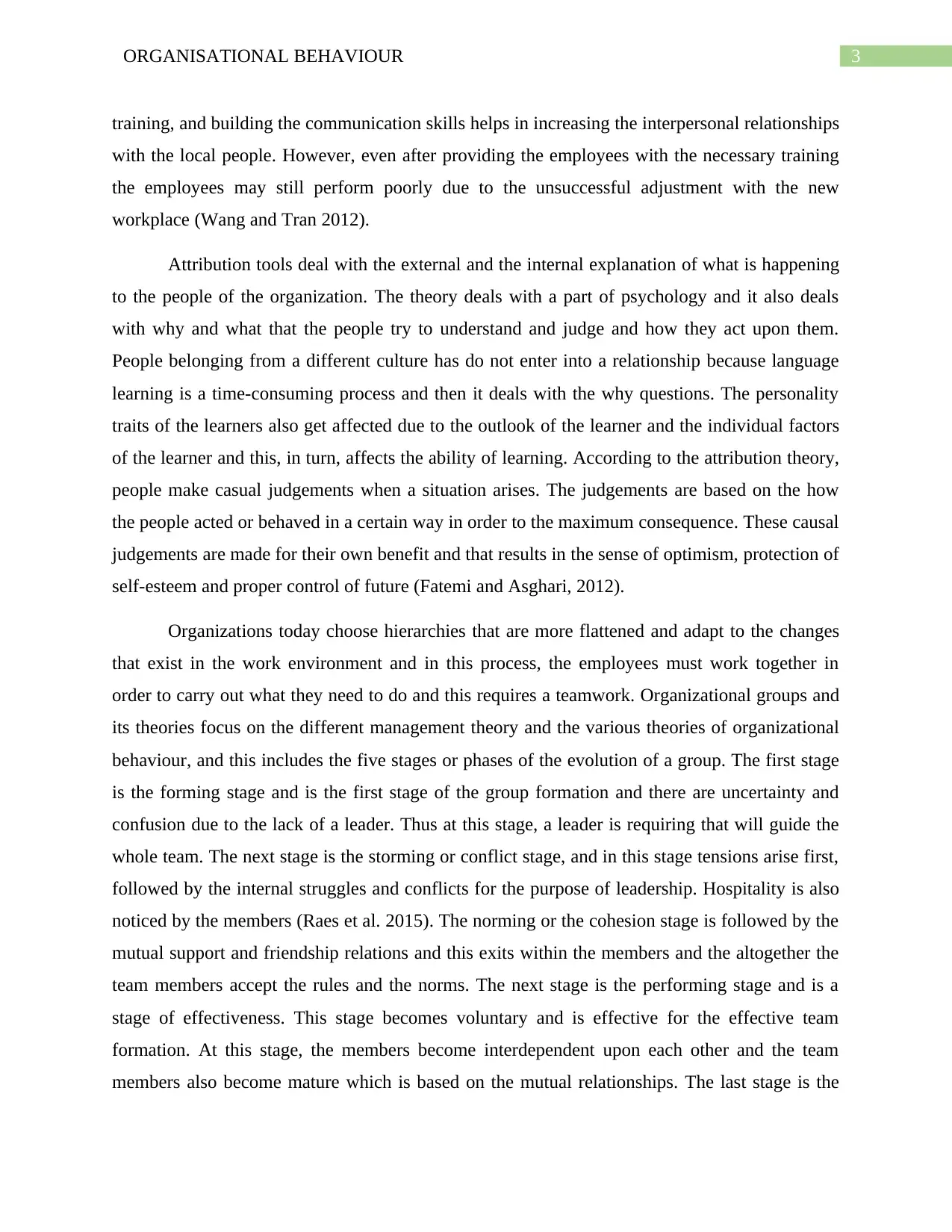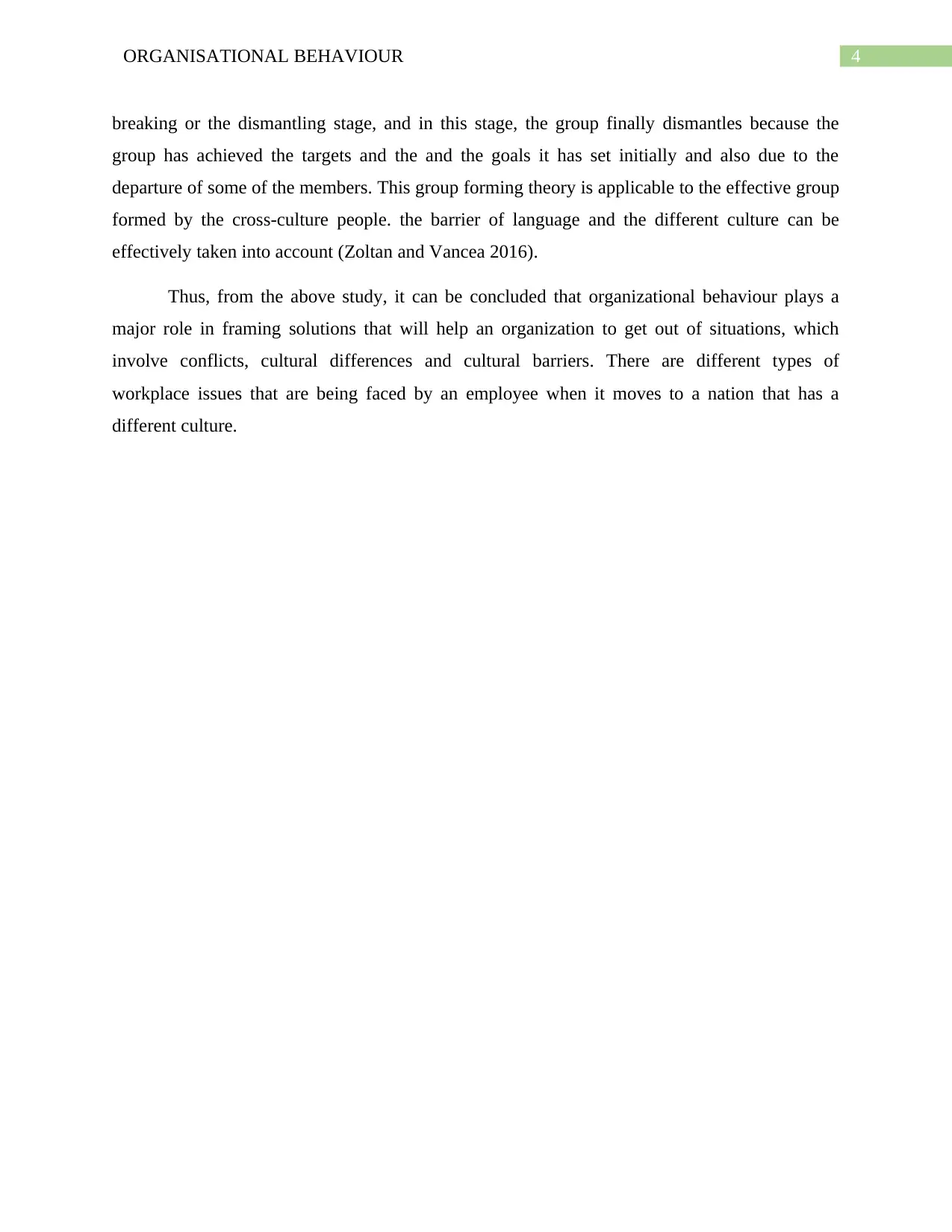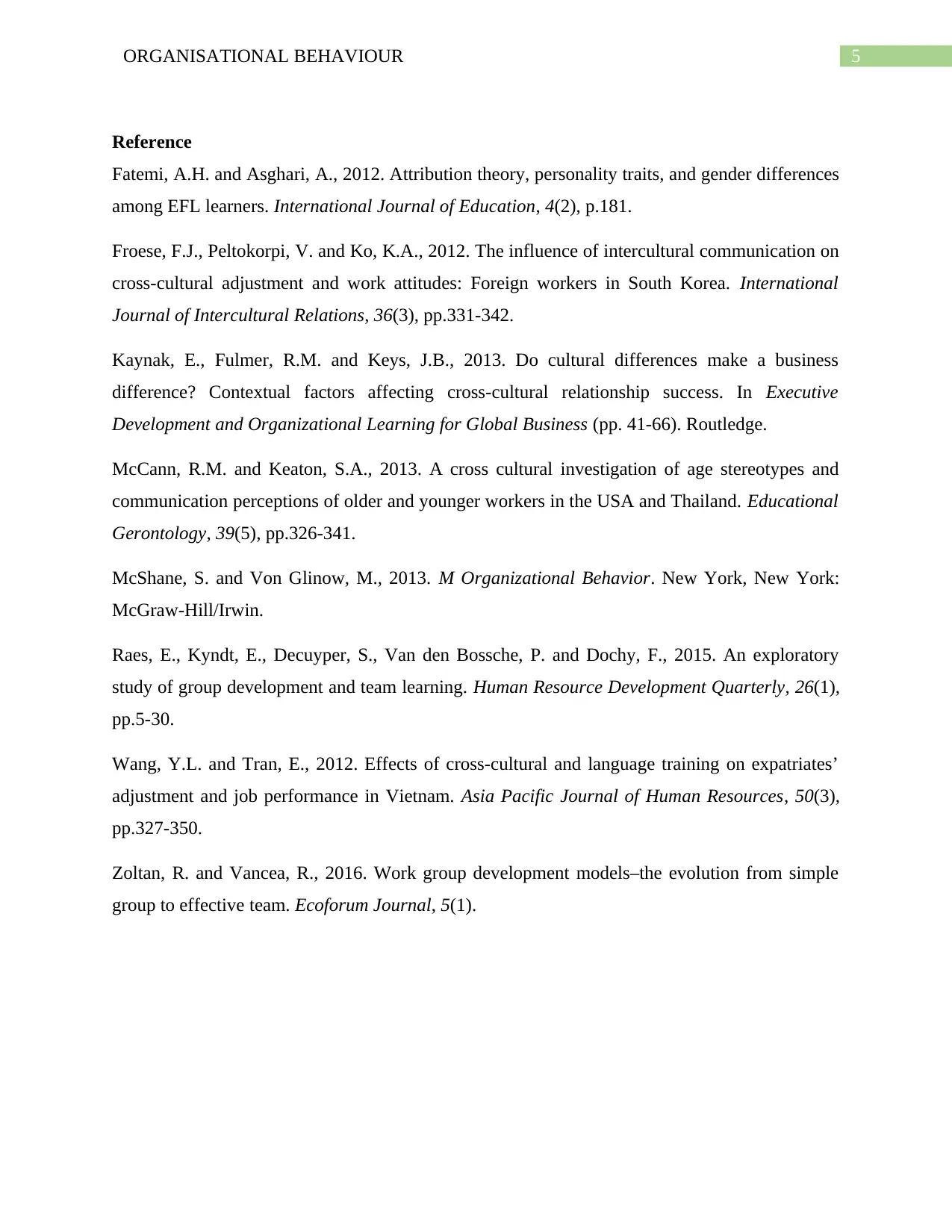Organisational Behaviour: Cultural Relationships and Stereotypes
VerifiedAdded on 2023/06/12
|7
|1960
|308
Essay
AI Summary
This essay explores organisational behaviour, focusing on the interplay between stereotypes and cross-cultural relationships within organizations. It examines age-related workplace stereotypes, contrasting perceptions of younger and older workers across different cultures. The analysis delves into the challenges faced by foreign workers, including language barriers and cultural adjustment issues, and the role of cross-cultural training provided by multinational companies. Attribution theory is discussed in the context of how individuals from different cultures make judgments and form relationships. Furthermore, the essay outlines the stages of group development and their applicability to cross-cultural teams, emphasizing the importance of understanding and overcoming cultural barriers for effective teamwork. Desklib offers a range of study tools and past papers to support students in understanding these complex topics.

Running head: ORGANISATIONAL BEHAVIOUR
Organizational Behaviour
Name of the Student:
Name of the University:
Author Note:
Organizational Behaviour
Name of the Student:
Name of the University:
Author Note:
Paraphrase This Document
Need a fresh take? Get an instant paraphrase of this document with our AI Paraphraser

1ORGANISATIONAL BEHAVIOUR
Organizational behaviour can be defined as the study of the behaviour of humans in an
organization, the study also involves the interface within which an organization and the human
behaviour interact in an organizational setting. organizational behaviour is applied in order to
study and create efficient business organization. The main theme is or the main idea behind the
study of the organizational behaviour is the efficient management of the workers through a
scientific approach. This study focusses on a topic “it is better to rely on stereotypes than to enter
into a relationship with someone from another culture without any idea of what they believe in”
and the various merits and the problems embedded in the topic (McShane and Von Glinow
2013).
The workplace stereotypes with respect to age between the same age younger and the
older worker, is based on the expectations and the beliefs of a person. It is important to note that
this does not occur based on the age nor based on the isolation, and it also reflects that the people
from different age group will exhibit the widespread societal stereotypes. A meta-analysis
conducted reveals that the stereotypes of the older person is more negative in comparison to the
stereotypes of the younger person. Research also suggested that the older person have more
generosity, wisdom and benevolence and the multiple stereotypes of the older person also exist
among the older persons. It is also found that the conceptions of the older individuals are more
complex in comparison to them. Generally, the older stereotypes have the negative overtones and
the younger stereotypes have a comparatively positive overtone which make them mentally and
physically more active with respect to the demands of the workplace. Also cross-culturally, the
stereotypes of the people that belong from the different age group varies largely. The generalized
stereotype of the age groups varies with respect to the variance in the cultural quarters. It is
important to note that across different cultures, people tend to view the world through the
differing ecologies, educational systems, values, philosophies, religions, social practices, social
structures. According to the authors, the role of ageing and communication differed across the
two different national cultures (McCann and Keaton 2013). According to the Japanese history,
when people of differing cultures interact, the adaptability is expected. However, with respect to
the manager it is not true. The managers that operate outside the home culture faces more
difficulties and make mistakes in taking managerial decisions. Tensions that occur between the
individuals is caused due to the cultural differences. The issues related to the cultural difference
Organizational behaviour can be defined as the study of the behaviour of humans in an
organization, the study also involves the interface within which an organization and the human
behaviour interact in an organizational setting. organizational behaviour is applied in order to
study and create efficient business organization. The main theme is or the main idea behind the
study of the organizational behaviour is the efficient management of the workers through a
scientific approach. This study focusses on a topic “it is better to rely on stereotypes than to enter
into a relationship with someone from another culture without any idea of what they believe in”
and the various merits and the problems embedded in the topic (McShane and Von Glinow
2013).
The workplace stereotypes with respect to age between the same age younger and the
older worker, is based on the expectations and the beliefs of a person. It is important to note that
this does not occur based on the age nor based on the isolation, and it also reflects that the people
from different age group will exhibit the widespread societal stereotypes. A meta-analysis
conducted reveals that the stereotypes of the older person is more negative in comparison to the
stereotypes of the younger person. Research also suggested that the older person have more
generosity, wisdom and benevolence and the multiple stereotypes of the older person also exist
among the older persons. It is also found that the conceptions of the older individuals are more
complex in comparison to them. Generally, the older stereotypes have the negative overtones and
the younger stereotypes have a comparatively positive overtone which make them mentally and
physically more active with respect to the demands of the workplace. Also cross-culturally, the
stereotypes of the people that belong from the different age group varies largely. The generalized
stereotype of the age groups varies with respect to the variance in the cultural quarters. It is
important to note that across different cultures, people tend to view the world through the
differing ecologies, educational systems, values, philosophies, religions, social practices, social
structures. According to the authors, the role of ageing and communication differed across the
two different national cultures (McCann and Keaton 2013). According to the Japanese history,
when people of differing cultures interact, the adaptability is expected. However, with respect to
the manager it is not true. The managers that operate outside the home culture faces more
difficulties and make mistakes in taking managerial decisions. Tensions that occur between the
individuals is caused due to the cultural differences. The issues related to the cultural difference

2ORGANISATIONAL BEHAVIOUR
are apparent at the early stage of the relationships than in later situations. However, when people
get to know after the first instance, the relationship dynamics improve and are defined by the
power rather than the culture. The tendencies related to the group culture are more evident and
apparent more inside a group rather than outside the group. According to the authors, people are
often aware of their own values and cultures in comparison to a person who is considered as an
outsider. Majority of the cross-cultural issues arises due to the strains between the cross-border
partners and that also involves the financial, political, organizational and strategic issues. The
authors emphasized on attributing the differences to the culture rather than to the context due to
the popularity of the national character stereotypes. National stereotypes and its roles was made
clear by contrasting with the managers that belong from America in comparison to the foreign
acquirers of other nationalities (Kaynak, Fulmer and Keys 2013). The foreign worker has
experienced language barrier issues when interacting with the host country nationals outside and
inside Japan and China. It has been seen that the foreign workers that belong from the western
countries are expected to face certain issues related to the language syntax, grammar and
alphabets. Research has shown that the American employee that exhibit the low Korean language
skills are treated with suspicion by the host country nationals, and thus they felt alienated and
lack of trust in the workplace. Studies in Japan have demonstrated that the lack of proficiency in
the country language has led to the unintentionally/intentionally led to the exclusion by the host
country nationals. The main thing to note here is that the it is natural tendency among the
nationals to interact with the people speak in their native language (Froese, Peltokorpi and Ko
2012).
Cross-cultural training is provided by multinational companies, that continuously guide
the employee to adjust according to the host country. The employee when arriving in the host
country undergoes the post-arrival training and aims to reduce the problems is an association
with the cultural adjustment. The post-arrival to the host country facilitates the employees with
the mentoring system, social support system and also with the essential resources. It is important
to note that, when the employees arrive into the new environment, the employees gain new
opportunities along with the local people and thus become open to information and rely less on
the native cultural view. This helps in learning the new culture and gets opportunities to adjust to
the host culture. Language barriers are one of the hindrances that the employees face when they
are assigned to the Asian countries. Language training is one of the parts of the pre-departure
are apparent at the early stage of the relationships than in later situations. However, when people
get to know after the first instance, the relationship dynamics improve and are defined by the
power rather than the culture. The tendencies related to the group culture are more evident and
apparent more inside a group rather than outside the group. According to the authors, people are
often aware of their own values and cultures in comparison to a person who is considered as an
outsider. Majority of the cross-cultural issues arises due to the strains between the cross-border
partners and that also involves the financial, political, organizational and strategic issues. The
authors emphasized on attributing the differences to the culture rather than to the context due to
the popularity of the national character stereotypes. National stereotypes and its roles was made
clear by contrasting with the managers that belong from America in comparison to the foreign
acquirers of other nationalities (Kaynak, Fulmer and Keys 2013). The foreign worker has
experienced language barrier issues when interacting with the host country nationals outside and
inside Japan and China. It has been seen that the foreign workers that belong from the western
countries are expected to face certain issues related to the language syntax, grammar and
alphabets. Research has shown that the American employee that exhibit the low Korean language
skills are treated with suspicion by the host country nationals, and thus they felt alienated and
lack of trust in the workplace. Studies in Japan have demonstrated that the lack of proficiency in
the country language has led to the unintentionally/intentionally led to the exclusion by the host
country nationals. The main thing to note here is that the it is natural tendency among the
nationals to interact with the people speak in their native language (Froese, Peltokorpi and Ko
2012).
Cross-cultural training is provided by multinational companies, that continuously guide
the employee to adjust according to the host country. The employee when arriving in the host
country undergoes the post-arrival training and aims to reduce the problems is an association
with the cultural adjustment. The post-arrival to the host country facilitates the employees with
the mentoring system, social support system and also with the essential resources. It is important
to note that, when the employees arrive into the new environment, the employees gain new
opportunities along with the local people and thus become open to information and rely less on
the native cultural view. This helps in learning the new culture and gets opportunities to adjust to
the host culture. Language barriers are one of the hindrances that the employees face when they
are assigned to the Asian countries. Language training is one of the parts of the pre-departure
⊘ This is a preview!⊘
Do you want full access?
Subscribe today to unlock all pages.

Trusted by 1+ million students worldwide

3ORGANISATIONAL BEHAVIOUR
training, and building the communication skills helps in increasing the interpersonal relationships
with the local people. However, even after providing the employees with the necessary training
the employees may still perform poorly due to the unsuccessful adjustment with the new
workplace (Wang and Tran 2012).
Attribution tools deal with the external and the internal explanation of what is happening
to the people of the organization. The theory deals with a part of psychology and it also deals
with why and what that the people try to understand and judge and how they act upon them.
People belonging from a different culture has do not enter into a relationship because language
learning is a time-consuming process and then it deals with the why questions. The personality
traits of the learners also get affected due to the outlook of the learner and the individual factors
of the learner and this, in turn, affects the ability of learning. According to the attribution theory,
people make casual judgements when a situation arises. The judgements are based on the how
the people acted or behaved in a certain way in order to the maximum consequence. These causal
judgements are made for their own benefit and that results in the sense of optimism, protection of
self-esteem and proper control of future (Fatemi and Asghari, 2012).
Organizations today choose hierarchies that are more flattened and adapt to the changes
that exist in the work environment and in this process, the employees must work together in
order to carry out what they need to do and this requires a teamwork. Organizational groups and
its theories focus on the different management theory and the various theories of organizational
behaviour, and this includes the five stages or phases of the evolution of a group. The first stage
is the forming stage and is the first stage of the group formation and there are uncertainty and
confusion due to the lack of a leader. Thus at this stage, a leader is requiring that will guide the
whole team. The next stage is the storming or conflict stage, and in this stage tensions arise first,
followed by the internal struggles and conflicts for the purpose of leadership. Hospitality is also
noticed by the members (Raes et al. 2015). The norming or the cohesion stage is followed by the
mutual support and friendship relations and this exits within the members and the altogether the
team members accept the rules and the norms. The next stage is the performing stage and is a
stage of effectiveness. This stage becomes voluntary and is effective for the effective team
formation. At this stage, the members become interdependent upon each other and the team
members also become mature which is based on the mutual relationships. The last stage is the
training, and building the communication skills helps in increasing the interpersonal relationships
with the local people. However, even after providing the employees with the necessary training
the employees may still perform poorly due to the unsuccessful adjustment with the new
workplace (Wang and Tran 2012).
Attribution tools deal with the external and the internal explanation of what is happening
to the people of the organization. The theory deals with a part of psychology and it also deals
with why and what that the people try to understand and judge and how they act upon them.
People belonging from a different culture has do not enter into a relationship because language
learning is a time-consuming process and then it deals with the why questions. The personality
traits of the learners also get affected due to the outlook of the learner and the individual factors
of the learner and this, in turn, affects the ability of learning. According to the attribution theory,
people make casual judgements when a situation arises. The judgements are based on the how
the people acted or behaved in a certain way in order to the maximum consequence. These causal
judgements are made for their own benefit and that results in the sense of optimism, protection of
self-esteem and proper control of future (Fatemi and Asghari, 2012).
Organizations today choose hierarchies that are more flattened and adapt to the changes
that exist in the work environment and in this process, the employees must work together in
order to carry out what they need to do and this requires a teamwork. Organizational groups and
its theories focus on the different management theory and the various theories of organizational
behaviour, and this includes the five stages or phases of the evolution of a group. The first stage
is the forming stage and is the first stage of the group formation and there are uncertainty and
confusion due to the lack of a leader. Thus at this stage, a leader is requiring that will guide the
whole team. The next stage is the storming or conflict stage, and in this stage tensions arise first,
followed by the internal struggles and conflicts for the purpose of leadership. Hospitality is also
noticed by the members (Raes et al. 2015). The norming or the cohesion stage is followed by the
mutual support and friendship relations and this exits within the members and the altogether the
team members accept the rules and the norms. The next stage is the performing stage and is a
stage of effectiveness. This stage becomes voluntary and is effective for the effective team
formation. At this stage, the members become interdependent upon each other and the team
members also become mature which is based on the mutual relationships. The last stage is the
Paraphrase This Document
Need a fresh take? Get an instant paraphrase of this document with our AI Paraphraser

4ORGANISATIONAL BEHAVIOUR
breaking or the dismantling stage, and in this stage, the group finally dismantles because the
group has achieved the targets and the and the goals it has set initially and also due to the
departure of some of the members. This group forming theory is applicable to the effective group
formed by the cross-culture people. the barrier of language and the different culture can be
effectively taken into account (Zoltan and Vancea 2016).
Thus, from the above study, it can be concluded that organizational behaviour plays a
major role in framing solutions that will help an organization to get out of situations, which
involve conflicts, cultural differences and cultural barriers. There are different types of
workplace issues that are being faced by an employee when it moves to a nation that has a
different culture.
breaking or the dismantling stage, and in this stage, the group finally dismantles because the
group has achieved the targets and the and the goals it has set initially and also due to the
departure of some of the members. This group forming theory is applicable to the effective group
formed by the cross-culture people. the barrier of language and the different culture can be
effectively taken into account (Zoltan and Vancea 2016).
Thus, from the above study, it can be concluded that organizational behaviour plays a
major role in framing solutions that will help an organization to get out of situations, which
involve conflicts, cultural differences and cultural barriers. There are different types of
workplace issues that are being faced by an employee when it moves to a nation that has a
different culture.

5ORGANISATIONAL BEHAVIOUR
Reference
Fatemi, A.H. and Asghari, A., 2012. Attribution theory, personality traits, and gender differences
among EFL learners. International Journal of Education, 4(2), p.181.
Froese, F.J., Peltokorpi, V. and Ko, K.A., 2012. The influence of intercultural communication on
cross-cultural adjustment and work attitudes: Foreign workers in South Korea. International
Journal of Intercultural Relations, 36(3), pp.331-342.
Kaynak, E., Fulmer, R.M. and Keys, J.B., 2013. Do cultural differences make a business
difference? Contextual factors affecting cross-cultural relationship success. In Executive
Development and Organizational Learning for Global Business (pp. 41-66). Routledge.
McCann, R.M. and Keaton, S.A., 2013. A cross cultural investigation of age stereotypes and
communication perceptions of older and younger workers in the USA and Thailand. Educational
Gerontology, 39(5), pp.326-341.
McShane, S. and Von Glinow, M., 2013. M Organizational Behavior. New York, New York:
McGraw-Hill/Irwin.
Raes, E., Kyndt, E., Decuyper, S., Van den Bossche, P. and Dochy, F., 2015. An exploratory
study of group development and team learning. Human Resource Development Quarterly, 26(1),
pp.5-30.
Wang, Y.L. and Tran, E., 2012. Effects of cross‐cultural and language training on expatriates’
adjustment and job performance in Vietnam. Asia Pacific Journal of Human Resources, 50(3),
pp.327-350.
Zoltan, R. and Vancea, R., 2016. Work group development models–the evolution from simple
group to effective team. Ecoforum Journal, 5(1).
Reference
Fatemi, A.H. and Asghari, A., 2012. Attribution theory, personality traits, and gender differences
among EFL learners. International Journal of Education, 4(2), p.181.
Froese, F.J., Peltokorpi, V. and Ko, K.A., 2012. The influence of intercultural communication on
cross-cultural adjustment and work attitudes: Foreign workers in South Korea. International
Journal of Intercultural Relations, 36(3), pp.331-342.
Kaynak, E., Fulmer, R.M. and Keys, J.B., 2013. Do cultural differences make a business
difference? Contextual factors affecting cross-cultural relationship success. In Executive
Development and Organizational Learning for Global Business (pp. 41-66). Routledge.
McCann, R.M. and Keaton, S.A., 2013. A cross cultural investigation of age stereotypes and
communication perceptions of older and younger workers in the USA and Thailand. Educational
Gerontology, 39(5), pp.326-341.
McShane, S. and Von Glinow, M., 2013. M Organizational Behavior. New York, New York:
McGraw-Hill/Irwin.
Raes, E., Kyndt, E., Decuyper, S., Van den Bossche, P. and Dochy, F., 2015. An exploratory
study of group development and team learning. Human Resource Development Quarterly, 26(1),
pp.5-30.
Wang, Y.L. and Tran, E., 2012. Effects of cross‐cultural and language training on expatriates’
adjustment and job performance in Vietnam. Asia Pacific Journal of Human Resources, 50(3),
pp.327-350.
Zoltan, R. and Vancea, R., 2016. Work group development models–the evolution from simple
group to effective team. Ecoforum Journal, 5(1).
⊘ This is a preview!⊘
Do you want full access?
Subscribe today to unlock all pages.

Trusted by 1+ million students worldwide

6ORGANISATIONAL BEHAVIOUR
1 out of 7
Related Documents
Your All-in-One AI-Powered Toolkit for Academic Success.
+13062052269
info@desklib.com
Available 24*7 on WhatsApp / Email
![[object Object]](/_next/static/media/star-bottom.7253800d.svg)
Unlock your academic potential
Copyright © 2020–2025 A2Z Services. All Rights Reserved. Developed and managed by ZUCOL.




